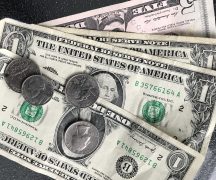By DAVID DUPONT
BG Independent News
When the Bureau of Labor Statistics announced at the end of last week that consumer prices were up 6.8 percent over last year, analysts were quick to point out that it was the highest it has been in almost 40 years.
That doesn’t mean, said Peter VanderHart, chair of the Economics Department in BGSU’s Schmidthorst College of Business, that inflation is the same as it was in the late 1970s and early 1980s, when reached the double digits.
“The prices were more widespread across different kinds of goods,” he said. “Everything was going up.” Some prices may have been up 7 percent, others up twice that much.
Today, inflation is felt most keenly in energy, food, and automobile sectors while services and clothing are less impacted.

“That does not mean it’s not a real problem,” he said. “It is. It is different and that suggests it might more transitory that the horrible stuff in the ’70s.”
In the interim decades inflation has been stable, 2-3 percent a year, and even a period of deflation during the Great Recession.
A little inflation, VanderHart said, can be a good thing, helping to moderate prices in some cases.
After getting used to low rates of inflation, more steeply rising prices came “as a rude surprise” to consumers, VanderHart said. It was “surprising and upsetting and rightfully so.”
Still, he said, “certainly the conditions were ripe for it.”
The government paid out stimulus checks that many people saved instead of spending. “The savings rate was unprecedentedly high during the pandemic.”
And the Federal Reserve was following a monetary policy of keeping interest rates at near 0 percent, even for long term borrowing. “Those two conditions are fertile ground for inflation to take hold.”
On the supply side, he said, “there were surprises that helped inflation along.”
Oil production was lower than people expected. All forms of energy – electricity, natural gas, gasoline, and heating oil – have been going up a lot because of the increased cost of crude oil and natural gas.
Then there were disruptions in the food supply. Disruptions in the manufacture of computer chips stymied the production of new cars. That put pressure on the price of used cars, especially “gently used” cars.
VanderHart experienced this himself when he went out to buy a car for his daughter. He saw what he’d have to pay and opted to put off the purchase for a year.
That’s the kind of consumer behavior inflation produces. The cost of a rump roast goes up, so the consumer opts for hamburger helper. The cost of gas goes up, so they decide not to take “that joy ride” or go on vacation.
These kind of actions by consumers distracted by inflation can be counterproductive for the economy.
VanderHart said he’s thinking that “once those supply issues are sorted out, and hopefully they are eventually, there’s not a reason the prices in those sectors should rise any more than in other sectors.”
Inflation also prompts workers to start demanding higher wages, he said. With an “unprecedented number of people quitting their jobs, there’s very many more job openings than there are people applying for jobs. It’s a good time to be picky in that regard.”
The food industry “is particularly prone to wage increases.” Meat processing plants and canneries call for workers to work in close quarters and scream to be heard.
Those are ideal conditions to spread a coronavirus, he said.
That’s pushed wages up, and companies have passed that along to consumers.
Federal Reserve policy is the key to taming rising prices, VanderHart said.
“Ultimately inflation is caused by too much money chasing too few goods,” he said, “and the ‘too much money’ part of it is really controlled by the Federal Reserve. They’ve been tremendously stimulatory with the bond purchases and close to zero interest rates over this period, and they’re recognizing this problem.”
To wean the economy off this stimulus they’re slowly reducing their bond purchases, and talking about raising interest rates in a year or so. “Those actions will in the long run, I think, stabilize inflation as long as they carry through on their stated intentions.”
VanderHart said: “I would think unless another strange occurrence happens, we’re going to gradually return to something more normal. Once the supply chain issues get sorted out with computer chips and food. Once energy supply comes back on line, partly because the price has risen and partly because the pandemic is, hopefully, lessening. That side of it is going to facilitate a return to normalcy.”
The Federal Reserve now recognizes that inflation is too high, and “it may not be just a blip,” he said. Now they’re taking action that in the long run will return the economy to their target for inflation of 2-3 percent a year.




